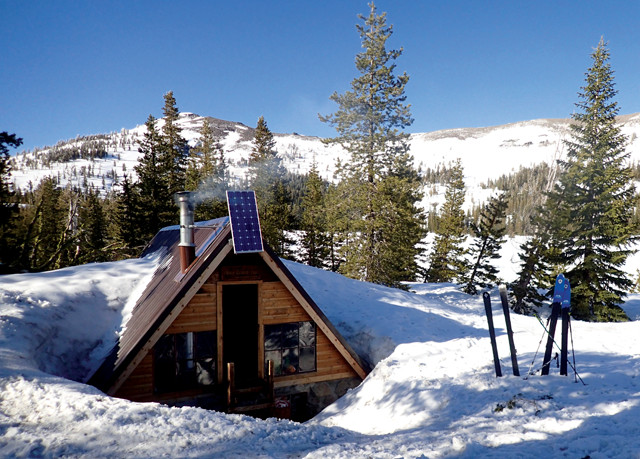
by Mary Caperton Morton Tuesday, September 19, 2017

California's record-setting snowpack this year may affect stress on faults throughout the state. In May 2017, only the roof of this two-story cabin in the Sierras was visible above the snow. Credit: Mary Caperton Morton.
On average, a cubic meter of snow weighs less than 100 kilograms, but heavy, compacted snow can weigh more than 500 kilograms per cubic meter, with glacial ice approaching 900 kilograms per cubic meter. In California, as elsewhere, the weight of winter snow and spring runoff pushes down on the landscape, affecting stresses on fault systems, which may trigger small quakes. As the snow melts and the runoff makes its way downstream, land rebounds, setting off more small earthquakes.
In a study in Science looking at the effects of water on mountains in California, researchers calculated how subsurface stresses under mountain ranges change with the seasonal water cycle by combining GPS measurements of seasonal land surface fluctuations with models of rock mechanics. The team found that the weight of winter water in the form of snow and ice pushes the Sierra Nevada down by about a centimeter and the Coast Ranges by about half a centimeter.
The researchers correlated the water cycle with a catalog of more than 3,600 small quakes that occurred in the state between 2006 and 2015, finding that faults along the eastern edge of the Sierras experienced more activity in late spring and early summer, whereas the San Andreas Fault in the western part of the state saw an increase in small quakes under magnitude 2 in late summer and early fall. The pattern reflects the seasonal redistribution of water in different regions as well as the nuances — like orientation and stress loading — of individual faults. The Sierras see more water-related quakes in the springtime aftermath of the wet winter months, when heavy winter snows and high runoff flows are still weighing down the range, while the Coast Ranges see more quakes once the land has started rebounding.
The authors caution that their findings don’t mean that all earthquakes in California will occur at certain times of the year. “There is no earthquake season,” said senior author Roland Bürgmann of the University of California’s Berkeley Seismological Laboratory, in a statement. When it comes to triggering water-affected faults, “it all depends on the details of the loading, the location of the fault and the geometry of the fault.”
© 2008-2021. All rights reserved. Any copying, redistribution or retransmission of any of the contents of this service without the expressed written permission of the American Geosciences Institute is expressly prohibited. Click here for all copyright requests.